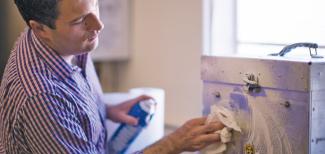Warm, sunny spring weather is a great opportunity for maintenance projects to freshen the kennel environment. Here are seven expert tips to help you make the most of spring cleaning your kennel. Professional all-breed handlers Joe Berkau and Burk Hughes of Southern California provided the backdrop for our photography, though kennel maintenance should be a year-round endeavor.
- Disinfect & Clean Thoroughly: Proper sanitation is critical to reduce disease problems in kennels. All surface areas should be disinfected after first being cleaned thoroughly to maximize the effectiveness of disinfectants. Organic materials, such as feces, urine and soil, decrease the effectiveness of many products. Bleach is an effective disinfectant, but be careful to use it minimally (1 cup bleach to 5 gallons water) and rinse thoroughly with water because it can be corrosive to a dog’s skin, paw pads and digestive system. Another option is using a quarternary disinfectant. Be sure to read and follow directions for maximum effectiveness.
- Fresh Coat of Paint: Areas that receive heavy wear and tear, kennel walls and even flooring, depending on the surface material, may need painted every year to look good. Paint provides moderate protection and improves a kennel’s overall look. Epoxy may work best. Though it costs more than paint, it gives greater protection and is more durable. Make sure to move dogs to a safe area and that there is proper ventilation before starting a painting project.
- Repair Concreate Cracks: Cracks and holes in concrete foundations, walls and doors send an invitation to rodents and insects. Damage from freeze-thaw cycles causes concrete to expand, eventually cracking. Likewise, salt used to melt ice erodes the pores of concrete and attracts water. Use a scraper to work epoxy into damaged areas to effectively seal cracks and holes and prevent further damage.
- Maintain Dog Doors: Most dog doors are neither chew-proof nor resilient to heavy usage. Check doors for cracks or gaps that may need repaired to prevent injury to dogs frequently going in and out. Keeping doors clean using a disinfectant spray is important to help them last longer and function better.
- Keep Grooming Tub in Tip-Top Shape: Grooming is one of the most important jobs in a show kennel, so it is imperative to keep your tub in good working order. Use caulking to seal the edges, and check the piping of the faucet and underneath the tub to be sure there is no leaking.
- Keep Dog Supplies Clean: Stainless steel water buckets and feeding bowls, brushes and grooming supplies, even the tack box that carries the supplies, should be thoroughly cleaned to reduce the spread of disease. Clean water buckets help to ensure dogs receive clean water, which is paramount to good health. Hair, as well as flakes of skin and coat, can cause deterioration to brushes and other grooming tools. Scrub with warm, soapy water to help keep dog supplies sanitary and ready for use.
- Monitor Dog Food Storage: Dog food should be kept in airtight containers to keep out rodents and insects. Spilled or improperly stored food is an invitation for an infestation. Check your dog food storage containers to be sure they don’t have cracks or loosely fitting lids.

